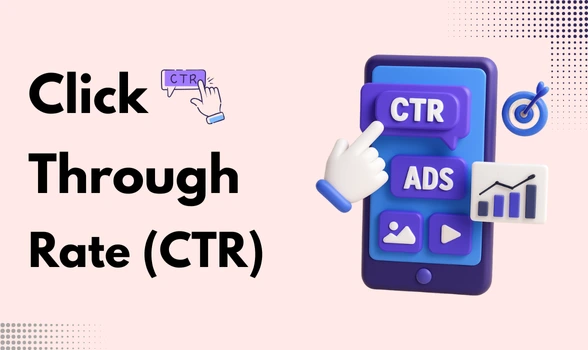Click-through rate (CTR) is a key digital marketing metric that measures the percentage of users who click on a specific link, advertisement, or call-to-action after seeing it.
It reflects how effective an ad or a webpage element is at capturing attention and driving user engagement. CTR is widely used to assess campaign performance across channels such as search ads, display ads, emails, and social media posts.
How is click-through rate calculated?
CTR is calculated by dividing the total number of clicks on an ad or link by the total number of impressions (times the ad or link was shown), then multiplying by 100 to express it as a percentage. For example, if an ad receives 50 clicks from 1,000 impressions, the CTR would be 5%. The formula is:
CTR = (Number of Clicks / Number of Impressions) × 100
This simple ratio helps marketers quickly evaluate how compelling their ads or content are to the target audience.
Why CTR is important
CTR is important because it indicates the relevance and attractiveness of your ads or content to your audience. A higher CTR means more people are interested enough to engage, signaling that your messaging, creative, and targeting are effective.
Additionally, platforms like Google Ads use CTR as a factor for quality scores, which can influence ad rankings and cost-per-click rates.
CTR also helps marketers optimize campaigns by identifying which ads or keywords are performing well and which need adjustment. Furthermore, since advertising budgets are often tied to performance metrics, improving CTR can lead to better return on investment by generating more clicks and potential conversions for the same budget.
What is a good CTR?
What qualifies as a good CTR varies by industry, ad format, and platform. Generally, search ads tend to have higher CTRs than display ads because they target users actively searching for related content.
For example, a CTR of 2% to 5% is often considered good for search ads, while CTRs below 1% may be typical for display or banner ads.
However, these figures can vary widely by niche or campaign goal. The key is to compare CTR against past performance benchmarks, industry standards, and conversion rates. A consistently low CTR can signal irrelevant ads or poor targeting, while a very high CTR might sometimes indicate misleading promotions, which could hurt long-term trust.
How to improve click-through rates
Improving CTR requires a blend of creative, technical, and strategic actions aimed at making ads more appealing and relevant.
Optimize ad creatives
Well-designed ad creatives capture attention and encourage clicks. Use compelling headlines, clear calls-to-action, and eye-catching visuals. Keep messaging concise and focused on user needs or benefits.
Audience targeting
Narrowing down your audience ensures your ads reach users most likely to be interested. Leverage demographic, geographic, behavioral, and interest-based targeting to improve relevance.
A/B testing for optimization
Regularly test different versions of your ads—headlines, images, ad copy, and CTAs—to identify which elements drive higher CTRs. Use data-driven insights to refine your campaigns continuously.
Enhance ad relevance with contextual advertising
Place ads on websites, videos, or content that aligns with your product or service. Contextual targeting helps present your ads to users already interested in similar topics.
Optimize for mobile user experience
Ensure ads and landing pages load quickly and display correctly on mobile devices. A seamless mobile experience encourages users to click and engage.
Capitalize on video and interactive ad formats
Video and interactive ads can boost engagement by providing richer storytelling and more immersive experiences. These formats often have higher CTRs than static ads.
Time ads strategically
Schedule your ads to appear when your target audience is most active or likely to convert. Timing campaigns to align with user behavior maximizes the chance of clicks.
In summary, click-through rate is a crucial metric that measures how effectively ads or links engage users. Understanding its calculation, significance, and typical benchmarks helps marketers assess performance. By optimizing creative elements, targeting, testing, and leveraging engaging formats, marketers can improve CTR to drive more traffic and conversions.




